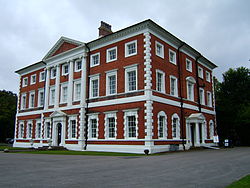Lytham Hall
| Lytham Hall | |
|---|---|
 |
|
| Location | Lytham, Lancashire |
| Coordinates | 53°44′39″N 2°58′36″W / 53.7441°N 2.9768°WCoordinates: 53°44′39″N 2°58′36″W / 53.7441°N 2.9768°W |
| Built | 1757–1764 |
| Architect | John Carr |
| Architectural style(s) | Palladian style |
| Governing body | Heritage Trust for the North West |
|
Listed Building – Grade I
|
|
| Designated | 1 December 1965 |
| Reference no. | 1219078 |
Lytham Hall is an 18th-century Georgian country house in Lytham, Lancashire, a mile from the centre of the town in 78 acres of wooded parkland. It is recorded in the National Heritage List for England as a designated Grade I listed building.
The manor of Lytham was recorded in the Domesday Book of 1086 as Lidun. In the 12th century it was given to the Benedictine monks of Durham Priory for the foundation of a monastic cell—Lytham Priory. Following the Dissolution of the Monasteries in the 1530s, Lytham Priory came into the possession of Sir Richard Molyneux. In 1606 the land was acquired by local landowner Cuthbert Clifton who built a house there. Cuthbert's descendant, Thomas Clifton, replaced that house with the current hall, which was built 1757–1764 to the design of John Carr of York. For the next two centuries the Clifton estate, at its largest, comprised 8,000 acres.
Ownership of the property descended to John Clifton (1764–1832) and thence to his son Thomas Joseph Clifton (1788–1851), who extensively remodelled the estate by extending the surrounding parkland. It passed via Colonel John Talbot Clifton (1819–1882), MP for North Lancashire, to his 14-year-old grandson, the colourful John Talbot Clifton (1868–1928), during whose stewardship the railway was built along the estate's southern boundary and part of the land sold for housing. During the First World War the house was used as a military hospital and after the Cliftons had moved to live in Ireland in 1919 and then Scotland in 1922 the house was somewhat neglected. Clifton was a passionate traveller and died in 1928 on an expedition to Timbuktu with his wife, Violet Beauclerk. She later wrote a biography of her husband, published under the title The Book of Talbot, which won the 1933 James Tait Black Prize, and was the last person to live in the house. Their dilettante film producer son, Henry de Vere Clifton, had squandered much of the family's wealth and the house had to be sold to Guardian Royal Exchange Assurance in 1963 for office accommodation.
...
Wikipedia

